#scolytidae
Text

this month's bugs. the outrageous one at the top right is real, Austrospirachtha carrijoi, a rove beetle that parasitizes termite nests
#commissions#bug doodles#bflyart#ariolimacidae#staphylinidae#tardigrada#aeshnidae#scelionidae#curculionidae#attelabidae#scolytidae#ligiidae#psychidae
3K notes
·
View notes
Text

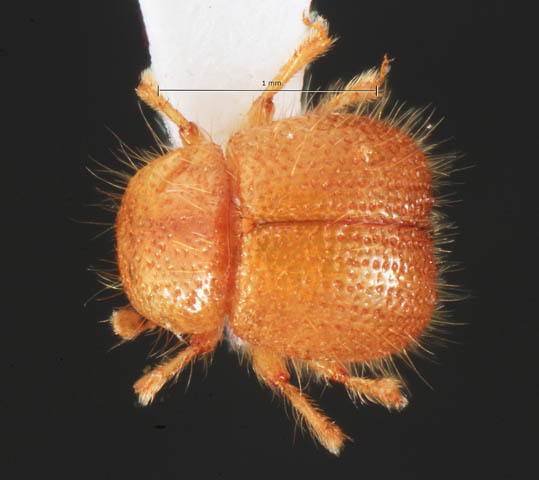
male Ambrosiodmus obliquus ambrosia beetle
img source
685 notes
·
View notes
Text
FAT nerd daughter swallows her DADs cum WTF
Nena sexy topless en la playa
Thick
Tinder Date Fucked my Wet Pussy in Heels and Stockings
Throated lil teen latina
My wife masturbate herself with a brush while watching porn
Real amateur wife flashing pussy voyeur public beach
hotels near agua caliente casino rancho mirage
Sexy ladyboy anal banged in many poses
Video gay twinks underwear and free nude tube videos After a supreme
#bilharziosis#nonconterminal#nonpleadable#nonmelodiously#tractates#motorises#B.E.M.#interclusion#resinlike#upsilonism#aratinga#melodise#Eopaleozoic#sulfonylurea#Scolytidae#act#Geer#ministral#broose#Sanchez
0 notes
Photo
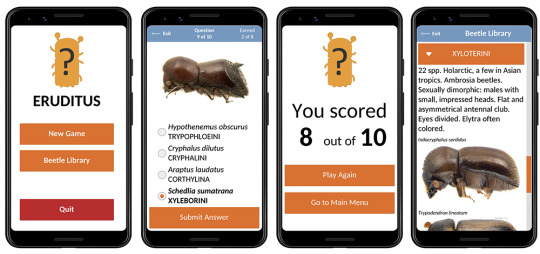

why yes i would like a bark beetle identification training app, how did you know?
33 notes
·
View notes
Text
Lupine Publishers- Agriculture Open Access Journal

Efficacy of Selected Attractants for Monitoring the Populations of the Redbay Ambrosia Beetle Xyleborus Glabratus Eichhoff (Coleoptera: Scolytidae) and Other Bark Beetles in the Florida Panhandle by Lambert HB Kanga
The redbay ambrosia beetle, Xyleborus glabratus Eichhoff (Coleoptera: Scolytidae) is a non-native insect first discovered in the United States in 2002 in Port Wentworth, Georgia. This beetle has a direct impact on the natural forest ecosystem because it vectors the fungus Raffaelea lauricola, which causes laurel wilt disease, a vascular disease of trees in the family Lauraceae, such as redbay, sassafras, camphor, silkbay, pondspice, bay laurel, the endangered pondberry and the economically important avocado. Originally from Southeast Asia the beetle has spread to coastal forests of Alabama, Florida, Georgia, Mississippi, North Carolina and South Carolina. This study surveyed previously un-surveyed areas of the Florida Panhandle, the Apalachicola National Forest usinga) A mixture of manuka and phoebe oil, b) Ethanol gel attractants and c) Hand sanitizer.The redbay ambrosia beetle was not detected in the Apalachicola National Forest; however, another 2,394 specimens of beetles belonging to the tribe Xyleborini and related tribes of the Scolytinae were found. Of these, more than 90% belonged to introduced (invasive) species- Lupine Publishers.
https://lupinepublishers.com/agriculture-journal/fulltext/efficacy-of-selected-attractants-for-monitoring-the-populations-of-the-redbay-ambrosia-beetle-xyleborus-glabratus-eichhoff.ID.000112.php
For more Lupine Publishers Open Access Journals Please visit our website
https://lupinepublishers.us/
For more Agriculture Open Access Journal articles Please Click
Here: https://www.lupinepublishers.com/agriculture-journal/
17 notes
·
View notes
Text
Lupine Publishers |Determination of Additional Parameters for Screening of Different Tea Cultivars against Shot Hole Borer: Comparative Assessment on Relationship of Plant Growth Parameters with Galleries in the Stem

Abstract
Shot whole borer (Xyleborusfornicatus Eichh.) (SHB) is considered as the most serious and economically important pest in tea plantations in Sri Lanka. Present study was done to determine the parameters for screening of different tea cultivars against SHB. Prune time assessments on plant growth parameters of plant breeding trials were used to correlate data on galleries per 30cm in the laboratory bioassay to determine their relationship on SHB infestation in tea. A set of new tea cultivars with known tolerant and susceptible cultivars were used in the study. The regression analysis indicated that the intermodal length, mean number of prune cuts and mean prune weight had a significant positive relationship (P<0.05) with SHB infestation and those could be considered as valid parameters for cultivar screening against SHB in tea. Formulated multiple regression model [Galleriesper 30cm units= (-8.27)+(0.1183 X1)+(1.987 X2), where; X1-mean number of prune cuts, X2-internodal length], was significant (P=0.007) and it explained 56.05% variation of galleries per 30cm (R2=56.05%). Mean number of galleries per 10cm stem had a significant (P<0.05) positive relationship (0.65) and the model explained 41.62% variation of galleries per foot (R2=41.62%).
Keywords: Cultivar Screening; Plant growth parameters; Shot hole borer; Tea
Introduction
Tea, Camellia sinensis (L.) o. Kuntze, is the main export crop and the second largest foreign exchange earner in Sri Lanka. Contribution of Tea to GDP of Sri Lanka is 2.6% [1,2]. Tea, which is grown in monoculture with shade trees, cover crops, mulches and hedgerows, provides a suitable environment for pests [3] to breed, disseminate and feed. Factors like weather changes, management practices, weeds, pest and diseases create stress conditions to Tea crop and affect its growth, yield quality, quantity and sustainability. In Sri Lanka, pests attack to Tea has become a severe problem as it would directly affect the yield and influence the national GDP in return. A wide range of insects (46 species) and mites (5 species) have been recorded as pests, causing damage to Tea at varying degrees [4]. Shothole borer (XyleborusfornicatusEichh.) (SHB) is the most serious and economically important perennial pest of Tea plantations in Sri Lanka [5], and has remained in nearly two thirds of the country's tea lands. Severe damage is evident in growing areas between elevations of 600-1200m [5].
As variations in the temperature and other climatic variables strongly influence their density and extent of population, they may exhibit some modifications to response the climate change [6]. SHB is a small beetle belonging to the family Scolytidae [7]. Larvae of these wood-boring beetles feed on the ambrosia fungus, Monacrosporiumambrosium [8]. Young mature female beetles make fresh galleries on young maturing Tea stems of pencil thickness after an initial dispersal flight. During plucking and other management practices, weakened branches break at the points where galleries are formed. These broken ends and prune cuts with remnant unprotected borer galleries serve as avenues for the entry of wood rotting fungi and subsequent termite infestations which lead to direct, indirect and long term loss of crop. SHB management occupies the highest cost from the total cost of production in Tea. SHB management is important mainly because of the mechanical stress and long-term secondary damages that it can cause, such as debilitation of branches resulting from wood rot. As chemical pests control poses various limitations due to nature of the pest as well as restrictions in the use of pesticides, screening and selection of tolerant cultivars would be an ideal solution. However, the conventional cultivar screening approach involves only exclusion of susceptibility in the absence of harnessing any growth measurements. It only screens the degree of damage sustained by using randomly selected bushes per replicate per cultivar [9].
Tolerance mechanismsrelatedphysiological orgrowth responses of the Tea plant due to SHB damage have many relationships and interactions with its biotic and abiotic environment. Therefore, determination of a relationship among Tea plant and the SHB attack is important when improving the cultivar screening methods. Some Tea cultivars recommended as tolerant for SHB using the existing screening method, may not behave as it is under field conditions. In some regions, Tea cultivars known to be tolerant have showed higher susceptibility to SHB. Reasons may be external factors such as soil nutrient content, plant health and vigor, climatic variations and pest pressure. Hence, an improvement of the existing method by using relationship of growth parameters with SHB attack would be a valuable finding to the industry. Present study was carried out with the following objectives of determination of additional parameters for cultivar screening against SHB in Tea; identification of convenient short cut method for cultivar screening against SHB and confirmation and validation of the susceptibility and tolerance of selected cultivars with known tolerance levels against SHB.
Material and Methods
The methodology of the study was consisted with two parts as; covering, monitoring and assessments of field data and laboratory bioassays with SHB.
Experimental site
Field trials were conducted at Field No.1 of St. Joachim Tea Estate, Rathnapura, Sri Lanka, which consists of the test cultivars; cultivar codes of 294, 29, 613, 139, 163, 142, 133, 62, 131, 151, 57, 107, 4, 12, 10, 1, 23/5, 10/1, 12/11 (5000 Series) and the standard cultivars; cultivar codes of TRI 2023, TRI 2027 (Tolerant), TRI 2025, TRI 2026 (Susceptible) and TRI 4042 (Moderately Tolerant).
Prune time assessments
Data on prune time assessments of test cultivars grown in Field No.1, St. Joachim Estate were obtained. Field establishment has done in July 1997 and the data were taken at second pruning; June 2006. Galleries per 30 cm unit: Samples were taken from different tea cultivars in separate plots maintained by Plant Breeding Division. Twenty bushes were randomly selected from plot at the time of pruning; five stems that approximately pencil thickness and 30 cm length were randomly taken to assess the number of galleries per stem. Means were calculated and mean number of galleries per 30 cm units was obtained. Mean number of prune cuts: Number of prune cuts was counted in prune cut surface of the bush and the mean value was calculated. Mean yield (kg of Made Tea/ha/yr): Data on yield of cultivar in different locations of plant breeding division trials was recorded weekly throughout the year. Cultivars used for plant breeding division trials were obtained from Deniyaya, Sri Lanka; cultivar codes of 62, 139, 613, 23/5, 12, 10, 4, 57, 1(LVP 75), TRI 2027, 133, 131 and Cicilton, Sri Lanka; cultivar codes of142, 10/1, 107, 4042, 12/11, 294, 163, 151, 29, TRI 2026. Mean yield were extrapolated as kg of Made Tea/ha/yr. Mean prune weight (kg/bush): Prune weight of each bush was taken separately in each cultivar and the mean value was calculated.
Assessment of growth parameters
Samples were drawn from plots consisting of 20 bushes of each test cultivar. Five shots from each plant were collected from randomly selected five bushes. Following growth parameters were assessed for Tea cultivars established in separate plots mentioned under section 2.1.Internodal length of 5th and 6th leaves and, bark thickness and stem diameter related to that intermodal length were measured by avoiding the succulent portion. After removing the succulent portion, mean number of nodes per shoot were counted.
Laboratory bioassay to screening of Tea cultivars against SHB using improved glass jar method
Laboratory bioassay was conducted using test cultivars mentioned under section 2.1, at Tea Research Institute (TRI), Talawakelle, Sri Lanka, during the period of August - November 2015. Healthy stems of 10 cm length and approximately in pencil thickness (1cm) were collected from bushes of the selected twenty- four cultivars. Experimental plots have been pruned before one and half years. TRI 2025 (the most susceptible) and TRI 2023 (the most tolerant) were taken as the standards. Freshly emerged, fertilized female SHB beetles were collected from infested Tea branches of Field No. 20, Nayapane Estate, Pussellawa, Sri Lanka and mass reared in culture tubes using artificial diet media adopted by [8], at TRI, Thalawakelle. Female beetles waiting at the top of the tubes (entangled in the cotton plug), were considered as already fertilized within the parent gallery and ready to make their dispersal flight. Among the collected beetles, actively moving females with bright black body colour and equal body size were used for the bioassay.
Test cultivars of cultivar codes; 294, 29, 613, 139, 163, 142, 133, 62, 131, 151, 57, 107, 4, 12, 10, 1, 23/5, 10/1, 12/11 (5000 Series) and standard cultivars of cultivar codes; TRI 2023, TRI 2027 (Tolerant), TRI 2025, TRI 2026 (Susceptible) and TRI 4042 (Moderately Tolerant) were used for the bioassay. Tea stems of 10 cm long and 0.95 cm diameter at both ends; from each cultivar were exposed to 15 healthy female beetles obtained from cultures, and replicated 10 times. Number of galleries formed and number of nibble points were recorded after 10 days.
Statistical Analysis
Recorded data on growth parameters were analyzed using Statistical Package Mini Tab 17. Correlation between plant parameters gathered in field experiment and galleries per 30cm units in stems examined in the laboratory bioassay were analyzed to evaluate relationship between them. Growth parameters, which were significant, were used to run subset multiple regressions to fit the model for galleries per 30cm units. Results of the bioassay (Mean No. of Galleries) were taken to correlate with field experiment data (galleries per 30cm units) to identify the relationship among short cut method (improved glass jar method) with field experiment data. Cluster analysis was done to confirm and validate the susceptibility and tolerance of selected cultivars with known tolerance levels against SHB. Field and laboratory infestation data were used for the analysis.
Results and Discussion
In this study, the prune time assessment data collected from LVP 75 trial on growth parameters were statistically evaluated using correlation, simple linear regression analysis and multiple regression analysis. Correlation between plant parameters and galleries per 30cm unit in stems were analyzed to evaluate relationship between them.
Figure 1: Galleries per 30 cm unit in different tea cultivars.
Prune Time Assessment
Galleries per 30cm
Galleries per 30 cm unit is the most reliable parameter to measure the SHB infestation. Method of sampling should be done based on the pest behaviour. SHB is a tiny beetle, which have no ability to fly a long distance. So that, the pest was cantered only over few locations even a single plot. Therefore, blocking of the plot and collecting of samples randomly from blocks was done. Galleries per 30cm unit values in different cultivars were shown in Figure! Mean number of prune cuts: There was a significant (p=0.028) correlation (r=0.49) between mean number of prune cuts and galleries per 30cm unit. In addition, 24% (R2=24%) variation of galleries per 30cm unit was explained by the regression model. High yielding cultivars; TRI 2025, TRI 2026, had higher number of branches (1914) providing an increased number of susceptible stems for pest attack.
Mean yield
There was no significant (p=0.618) correlation (r=-0.12) between mean yield and galleries per 30 cm unit. In addition, 1.41% (R2=1.41%) variation of galleries per 30cm unit was explained by the regression model. Total yield reduction throughout the pruning cycle may have significant inverse correlation with the pest damage. [9], reported that there was a significant (p=0.001) correlation (r=- 0.911) between mean yield and number of galleries on TRI 2025 (susceptible) cultivar. However, present study was conduct by using 21 different cultivars with different susceptibility levels, which also shows negative correlation less than that of the previous study. Mean prune weight: There was significant (p=0.028) correlation (r=+0.49) between mean prune weight and galleries per 30 cm unit. In addition, 24.18% (R2=24.18%) variation of galleries per 30cm unit was explained by the regression model. Prune weight consists of the most immature parts of the bush, which also support to SHB attack. Therefore, there is a positive relationship with the pest infestation.
Assessment of growth parameters
Intermodal length: There was a significant (p=0.008) correlation (r=0.66) between intermodal length and galleries per 30 cm unit. Moreover, 42.9% (R2=42.9%) variation of galleries per 30 cm unit was explained by the regression model. Intermodal length is a key parameter, which explains the pest infestation with the positive relation. For further confirmation, it is required to assess a large number of sample units with different cultivar in different locations. Mean number of nodes per shoot: There was no significant (p=0.092) correlation (r=-0.45) between mean number of nodes per shoot and galleries per 30 cm unit. 20.31% (R2=20.31%) variation of galleries per 30cm unit was explained by the regression model. Number of nodes was counted apart from the succulent part of the shoot (only semi mature stems are attacked by SHB). According to [10], 75% of the galleries are constructed at the nodes. However, present study was focused on number of nodes per shoot and results indicated that SHB infestation has no significant correlation with number of nodes per shoot.
Bark thickness: There was no significant (p=0.271) correlation (r=-0.26) between bark thickness and galleries per 30 cm unit. In addition, 6.7% (R2=6.7%) variation of galleries per 30cm unit was explained by the regression model. According to [11], beetles prefer stems with bark for gallery construction and the difference was highly significant (p=0.001).However, results of present study showed that bark thickness has no significant effect on pest infestation. But there is a negative relationship with pest infestation.
Figure 2: Scatter plot of intermodal length vs. galleries per 30cm unit vs. mean number of prune cuts in different cultivars.
Stem diameter: There was no significant (p=0.508) correlation (r=-0.18) between stem diameter and galleries per 30cm unit. 3.19% (R2=3.19%) variation of galleries per 30cm unit was explained by the regression model. Findings of [4], indicated that branch thickness have little influence on the number of brood galleries. Correlation coefficients were calculated to see the factors most closely related with number of galleries. There were poor linear correlations between number of galleries and branch diameter (r=0.508, p=0.001). Multiple regression model: Multiple regression model was significant (p=0.007) and 56.05% (R2=56.05%) variation of galleries per 30cm unit was explained. It declares that parameters (i.e. intermodal length, mean number of prune cuts and mean prune weight) were significant with galleries per 30cm unit (Figure 2). Multiple regression model of galleries per 30cm unit, explained only intermodal length and mean number of prune cuts.
Developed multiple regression model; Galleries per 30cm=- 8.27+0.1183 X1+1.987 X2.
(Where X1 - mean number of prune cuts and X2-Intermodal length)
Figure 3: Distribution of mean Number of galleries per 10cm Stem in different cultivars.
Laboratory bioassay to screening of Tea cultivars against SHB by improved glass jar method
Mean number of galleries per 10cm Stem: There was a significant (p=0.004) correlation (r=0.65) between mean number of galleries per 10cm Stem unit and galleries per 30cm (Figure 3). In addition, 41.62% (R2= 41.62%) variation of galleries per 30cm unit was explained by the regression model. Correlation between field infestation and laboratory results was significant with high positive relationship. Hence, findings foresee potentials of harnessing the parameter for industry requirement of a short cut method to cultivar screening against SHB. Improved glass jar method is a convenient method to develop as short cut method. It has some limitations that can overcome through further improvement. Determination of effective pest pressure (number of beetles per bottle), effective stem length and effective number of stem are much important. Wet floral foam was used to maintain stem moisture in the present study, which gave consistent results. However, its limitation of beetles entangle with wet floral foam, can be avoided using a piece of 'Formica sheet over the wet floral foam to restrict the path. Development of a model for pest infestation is required to be optimized the short cut method. Cultivar screening from control laboratory and field conditions separately in different locations, which has active pest pressure by using the same age and same cultivar samples is essential to fit the model. Model can be used to predict infestation even at low pest pressure areas.
Cultivar screening by using nursery tea plants in SHB active areas with natural as tested previously is another cost-effective method. Mean number of galleries were obtained to measure the pest infestation levels. However, amount of wood dust remove from the boring of tunnels has another approach to measure the cultivar susceptibility. Correlation between number of nibble points at nodes vs. number of nodes: There was a significant (p=0.045) correlation (r=0.43) between number of nibble points at nodes and number of nodes. In addition, 18.65% (R2=18.65%) variation of number of nibble points was explained by the regression model. However, total number of nibble points was recorded as 77.197% at nodes and the remaining 22.8% represented the nibble points located in between nodes. These results indicated that the beetle's preference is higher for nodes than the inter nodes.
Results obtained from parameter testing, were exposed to descriptive statistical analysis and summary of the results declared that, mean number of prune cuts (p=0.028, r=0.49), mean prune weight (kg/bush) (p=0.028, r=0.49), intermodal length (cm) (p=0.008, r=0.66) and mean number of galleries (p=0.004, r=0.65) are effective parameters to determine SHB attacks in tea plantations, while mean yield (green leaf)(kg/ha/yr)(p=0.618, r=0.12), bark thickness (mm) (p=0.271, r=0.26), stem diameter (p=0.508, r=0.18), number of nodes per shoot (p=0.092, r=0.45) and number of nibble points at nodes vs. number of nodes (p=0.045, r=0.43) are not effective parameters for the same.
Confirmation and validation of the susceptibility and tolerance of selected cultivars
By exposing field and laboratory infestation results to cluster analysis, susceptibility level of selected cultivars was confirmed and clustered as Known susceptible and Tolerant cultivars. Among those 1, 294, 133, 29, 151 cultivars were categorized as susceptible and 131, 4, 139, 613, 163, 62, 23/5, 12/11, 107, 10/1, 142, 10, 12 were categorized as tolerant.
Conclusion
Cultivar screening against SHB in Tea has several limitations leading to inconsistency in cultivar response to borer attack under field condition. Hence this study was carried out with the objective of determination of additional parameters and identification of convenient short cut method for cultivar screening against SHB in Tea. Amongst the parameters analyzed, intermodal length (p=0.008, r=0.66 and R2=42.9%), and mean number of prune cuts (p=0.028, r=0.49 and R2=24%) were found to be effective in using for cultivar screening against SHB. These parameters exhibited greater correlation coefficient and coefficient of determination, which provide precision in data. Hence, the overall results presented avenues for recognizing the potential of cultivars for the tolerance against SHB by not only looking at the susceptibility but also examining the levels of plant response to the pest attack and defence mechanism. Relationship between field infestation (galleries per 30cm unit) and laboratory infestation (mean number of galleries per 10cm Stem) were significant with high positive relationship (p=0.004, r=0.65 and R2=41.62%). The trend identified from the present study has remarkable outcome that can be utilized on developing short cut method for SHB with further modification of improved glass jar method.
For more Lupine Publishers Open Access Journals Please visit our website: https://lupinepublishersgroup.com/
For more Agriculture Open Access Journal articles Please Click
Here: https://www.lupinepublishers.com/agriculture-journal/
To Know More About Open Access Publishers Please Click on Lupine Publishers
0 notes
Text
Bark
Environmental benefits
“The bark of different trees has evolved to make best use of the environment in which each species occurs. Scots pine (Pinus sylvestris) bark offers protection from fire. In prehistoric times, parts of Scotland’s woodlands would have been influenced by fires, which would have occasionally swept through areas of forest. While this may seem devastating, when forests were more extensive, pinewood ecosystems would actually have benefited from such natural disturbance, as it can clear away rank vegetation, leaving a fertile bed on which pine seeds can germinate. Many Scots pines have very characteristic thick protective plates on their bark, and it is thought that in areas more prone to fire the bark may become locally adapted to offer extra protection.
Many trees have chemicals within their bark, which protect against fungal and insect attack. Birch (Betula spp.) bark is high in volatile oils (this is why it’s also great for lighting fires!), and is so waterproof and resistant to decay that tubes of birch bark can still be found on the forest floor after the wood inside has decayed. The bark of oak (Quercus petraea) is very high in tannins, which are toxic and protect the tree from insects.
Aspen (Populus tremula) bark has some fascinating features. On many trees it is a conspicuous greenish-grey colour and it is actually a result of the tree being one of the few that can photosynthesise through its bark. It also has characteristic diamond-shaped marks on the bark that are in fact tiny breathing holes called lenticels.”
(https://treesforlife.org.uk/into-the-forest/habitats-and-ecology/ecology/tree-bark/)
(Brown, R.W., Lawrence, M.J. & Pope, J. (2004) Animals – Tracks, Trails and Signs. Hamlyn: London.)
- “The deep fissures and crevices on the bark of an old oak or Scots pine are a haven for many species of insects and spiders.”
- “The crested tit (Parus cristatus) is very much a pinewood bird that includes in its diet insects picked from the bark and twigs in the branches.
- “Even after a tree has died, bark can be a haven for all sorts of wildlife. Bats, such as the brown long-eared bat (Plecotus auritus), sometimes roost beneath loose bark, and a multitude of invertebrates also live out their lives in this hidden world.
- “As their name suggests, bark beetles (family Scolytidae) are among the insects that use bark. “ – to live in
- “Many mammals eat bark, and by looking at the height of the damage, we can find out what mammals are present in an area”
- By animals eating the bark, this allows fungi and other organisms to enter the tree which damages it.
- “when a tree is killed or harmed by bark damage, valuable dead wood habitat can be created for fungi, insects and many other organisms.”
- “While bark’s main purpose is to protect the tree, it also serves as a good example of how every surface, nook and cranny in woodland can provide food, shelter, or both, for myriad living things, thereby increasing the overall biological diversity in the forest.”
(Written by Dan Puplett.)
Sources and Further Reading
(Mitchell, A. (1982) Trees of Britain and Northern Europe. Collins: London.
Steven, H.M. & Carlisle, A. 1959. The Native Pinewoods of Scotland. Oliver & Boyd: Edinburgh.
Street, L. & S. (2002) The importance of Aspens for lichen. In: Cosgrove, P & Amphlett, A. (eds.). The Biodiversity and Management of Aspen Woodlands: Proceedings of a one-day conference held in Kingussie, Scotland, on 25th May 2001. The Cairngorms Local Biodiversity Action Plan: Grantown-on Spey.”)
0 notes
Text
Dendroctonus valens added to the EPPO Alert List
The red turpentine beetle, Dendroctonus valens (Coleoptera: Scolytidae), originating from North America was introduced into China (counties of Yangcheng and Xinshui - Shanxi province) in the early 1980s. In 1999, it was found in Hebei province and by 2003 this bark beetle had spread to 85 counties in 3 provinces of Northern China covering an area of more than 700 000 ha causing damage to pine trees. In China, it is estimated that D. valens has killed more than 10 million pine trees since its introduction, mainly Pinus tabulaeformis (Chinese red pine), a species which has been widely planted in monoculture during reforestation programmes. Genetic studies conducted in China in 2005 indicated that D. valens was introduced from the Pacific Northwest of the USA, probably via multiple introductions. However, other studies comparing the symbiont fungi associated with D. valens in North America and China, suggest an introduction from Eastern North America. It is suspected that the introduction of D. valens into China has been associated with imports of unprocessed logs of Pinus ponderosa for use in mine construction. Considering this ‘continental jump’ and the severity of damage reported from China, the EPPO Panel on Quarantine Pests for Forestry recommended that D. valens should be added to the EPPO Alert List
Laria azevedo's insight:
https://www.livestocktradingcompany.com/product/guineas-pigs-for-sale/
0 notes
Photo

Effectiveness of Selected Botanicals Against Coffee Borer. Hypothenemus spp. (coleopteran: scolytidae) in Coffee canephora Authors: Ms. Mariel B Guban and Dr. Evelyn D. Singson H. hampei, otherwise known as the coffee berry borer, is the most serious pest of coffee in many of the major coffee-producing countries in the world. Crop losses can be very severe and coffee quality from damaged berries is poor because of this pest. Because Cavite State University produces its own coffee, this is one the problems they’ve facing yearly. As producing it, they have to maintain the quality of coffee they plant. Coffea canephora From over 100 species within the Coffea genus, C. canephora is a coffee species that is well adapted to warm and humid equatorial lowlands, and is considered more resistant to diseases and pests. Since coffea canephora can adjust to the warm climate of the Philippines, Cavite State University uses it to prevent the coffee berry borer. Coffea canephora, is usually used in coffee blends or in the preparation of soluble coffee and is known for its higher bioactive compounds content such as caffeine and chlorogenic.
0 notes
Text
Leafstalks as a habitat for bark beetles (Col.: Scolytidae)
http://dlvr.it/PprD98
0 notes
Text

bus bug stop. featuring a giraffe weevil, a hylastes bark beetle (with phoretic mite), and @bedupolker's recent weevil guy
#bflyart#bug people#curculionidae#attelabidae#scolytidae#weevil#giraffe weevil#bark beetle#Trachelophorus giraffa#hylastes
1K notes
·
View notes
Text

i recently solved a fun little bug mystery at work and i thought it might be interesting to write up a step-by-step narrative of how i did so, as a sort of example of the kinds of things i get to do for my job. this is a stupidly long post because i have no editorial self-control so i'm putting the rest under a cut.
the above insect is a bark beetle, one of a series of 6 specimens i found in a drawer at work. they did not have species labels on them, and the collection labels indicated that they were collected in 1997 from "Chinese Cedrus used for artifical christmas trees." the infested wood had been intercepted and the beetles collected and pinned, but whoever was working in the lab at the time wasn't able to suss out the species, which is extremely reasonable because even IDing american bark beetles to species can be a massive pain in the ass, let alone ones from asia.
the beetles were clearly in the genus Phloeosinus based on the shape of the antennae and the large spines on the elytral declivity (the ass area), and whoever pinned them at least got them that far themselves, but determining the actual species was going to be a lot harder. even american beetles in this genus can be devilishly hard to confidently ID to species since they often look alike and also are quite morphologically variable in ways the bleed into each other. they are pretty cool though and those ass spines are usually critical in species-level identification
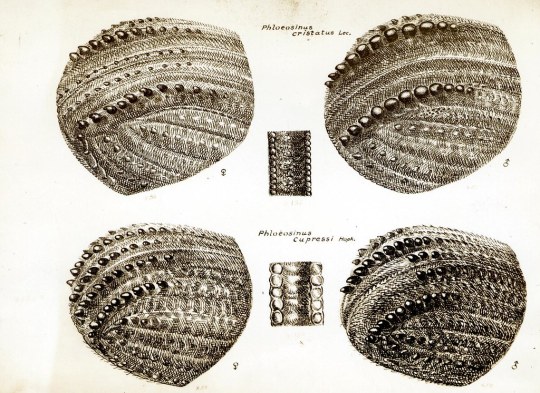
btw since i'm going to be writing out this word a lot in this post, it's pronounced roughly as "flea-o-sign-us" if you're curious.
determining bark beetle species is often made much easier by knowing what tree the beetle came out of since most bark beetles (but not ambrosia beetles, which are also scolytid/scolytine beetles but a whole other can of worms grubs) are highly host-specific, usually being adapted to only a certain tree species or genus or small group of related genera.
so Cedrus is the genus for eurasian cedar trees, and there is one species of Cedrus native to china, Cedrus deodara, but that seems like an odd choice of plant to harvest and send to america for artificial christmas tree trunks. most actual Cedrus species are from the mediterranean area. however there are also some chinese trees in the cypress family Cupressaceae (+Taxodiaceae) that are called cedars, and in fact most species of Phloeosinus are exclusively found in trees in this family. one likely species is Cunninghamia lanceolata, traditionally called "chinese fir" despite not being a fir but also more recently marketed as "chinese cedar" because that's how common names for species go.
oh and there is also the tree Toona sinensis in the family Meliaceae that's ALSO sometimes called "chinese cedar" for some reason but more importantly also called "beef and onion plant" lmao, but that was an even worse candidate for an artificial christmas tree trunk and also not a known host for the beetles. easily discounted but i had a laugh.
so my first angle of attack was to assume that the collection labels were correct and the beetles were in fact from a Cedrus tree. i was able to find a list of about a half dozen Phloeosinus species known to attack Cedrus cedars, but none of them were native to china. this would most likely mean that one of the mediterranean species had been transplanted to china for cultivation, which is entirely plausible. after digging though a bunch of literature i wasn't able to find a good key for Phloeosinus species in the entire area i wanted, but found a couple regional keys covering geographic ranges that when combined covered about what i wanted. for non-biologists, this is what a species key looks like:

sort of a choose your own adventure kind of thing but for determining a creature's true identity. anyway none of the results i got from these keys led to species who's descriptions matched the one that i had. i should also mention that my specimens had a rather distinctive feature unlike any other Phloeosinus species i'd ever seen before, which was an elytral vestiture consisting of these really funky little black explanate scales:
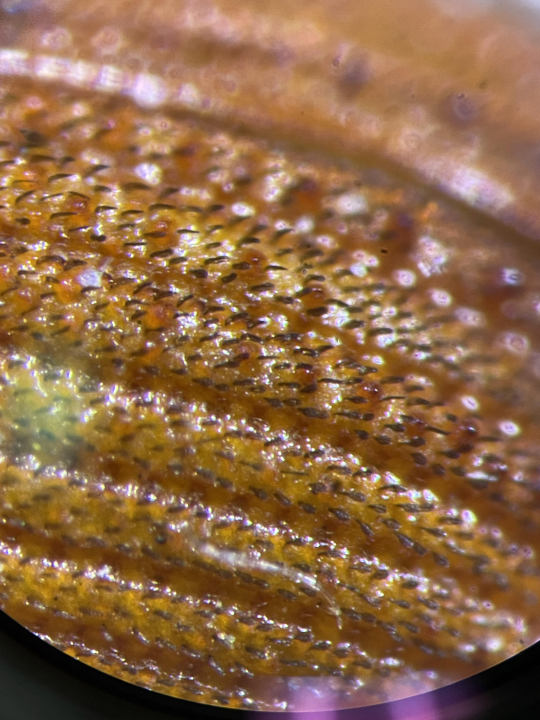
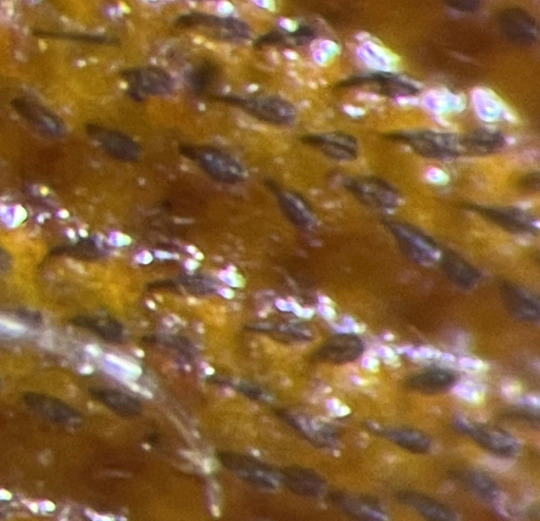
most Phloeosinus species have some kind of vestiture on their elytra but all the ones i'm familiar with have the hairs and scales light-colored and never shaped anything like this, so i figured that the description of the correct species would surely mention these scales.
so anyway dissatisfied with this avenue, i decided that the next most likely option is that whoever made the labels for the specimens was told that they had come from "chinese cedar" by the importer and had just assumed that meant Cedrus but it was actually one of the cypress family cedars. again most of the described species do in fact use Cupressaceae as hosts.
so next i found this UN report with a (hopefully) comprehensive list of all non-EU bark and ambrosia beetle species that attacked conifer trees. i culled from that a list of Phloeosinus species listed as coming from "asia." since that was too broad of an area, i then looked up all of these species in the species catalogues listed in the report, mostly Alonso-Zarazag et al (2007), though some were also listed in Wood and Bright (1992) or Bright and Skidmore (2002), which i happen to have physical copes of. from these i could narrow the list down to just species found in china.
now things became difficult because there are no keys to chinese Phloeosinus, or at least none in english. also even just written descriptions of many of these species were impossible to find because they were all written like 60-100 years ago and usually in chinese or german or french and had never been translated or uploaded anywhere online. likewise almost none of them had research-grade (or any) photos anywhere online.
so after hours of fruitless digging, the best i could come up with was a guide to scolytine beetles of korea (PDF link), which contained a key with a handful of the species on my list and did include english descriptions of these. now one of the species in the guide, P. perlatus, IS DESCRIBED as having dark scales, and my specimens did seem to land on that species when i ran them through the key. that's promising! and the hosts were on my list of possible non-Cedrus chinese cedars! also promising! buuuut something just didn't sit right with me. parts of the species description in that paper just didn't seem to quite match my specimens, like for example the size was a little off, described as being 2.4-3.4mm long, while all of mine were in the 3.3-3.6 range. plus the photos of the species, while distressingly low-resolution, just didn't look like mine.
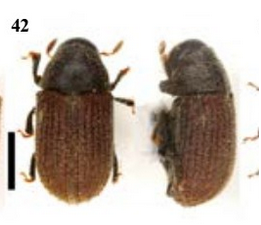
okay so that was dissatisfying. i'd managed to whittle down my list of suspects a good deal from what little scraps of information i could find about them through my sleuthing, either the wrong hosts or the ones that did have english descriptions available online like in that korean guide didn't fit, but i was still left with several possible candidates and no way to narrow it down further, of course this all assuming that the beetles i had on my hands even were a species that had been scientifically described and named. bark beetles are a huge group of critters and many are quite understudied, especially in asia, and a bunch of new species are described every year!
i was about ready to just give up, but then by coincidence i had a reason to email a couple of high-level bark beetle researchers about a different beetle mystery i was also working on, which was in a group that they were the authorities on. on a whim, i mentioned my Phloeosinus conundrum to them to see if they had any ideas and they recommended i contact Dr. Roger Beaver. yeah, i know right? fucking kickass name i'm so jealous. sidenote: it's so funny how many bark beetle researchers have extremely appropriate names, like two of the biggest names in the field are Steve Wood and Dave Wood. no relation.
so anyway i contacted Dr Beaver, who had done some research on east asian Phloeosinus in the past and he was kind enough to send me an unpublished provisional key to chinese species that he had written up a few years ago. using that key, i ended up at "P. pertuberculatus (?=sinensis)" which means that there was some suspicion that P. pertuberculatus and P. sinensis were the same species, just described and named independently by two different entomologists (Hans Eggers and Karl Eduard Schedl respectively), as often happened, especially in the glory days of insane 18th-20th century european entomologists describing literally thousands of new species during their careers.
now these two species WERE both on my final list of suspects of chinese Phloeosinus species that hadn't otherwise been eliminated for one reason or another, and both had Cunninghamia "cedar" trees as known hosts. Dr Beaver was then kind enough to scan and send me the original descriptions of these two species:
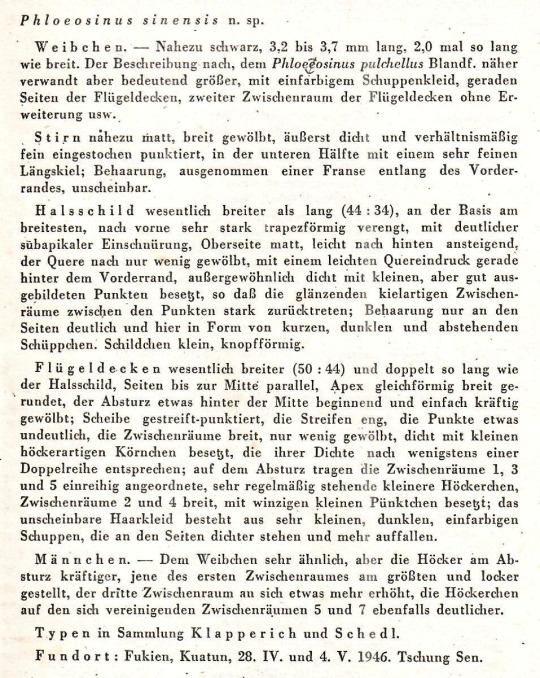
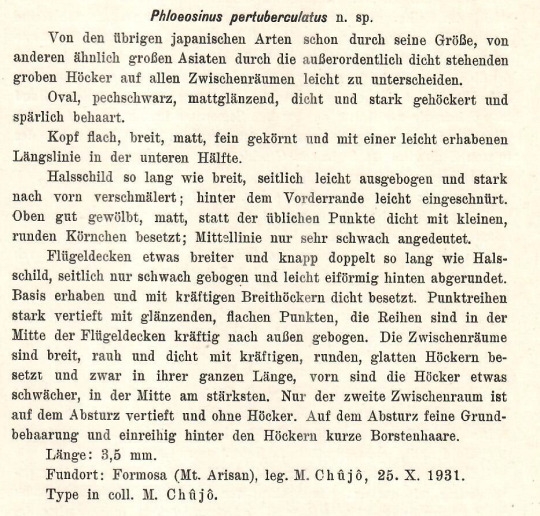
which i was able to use google translate on:
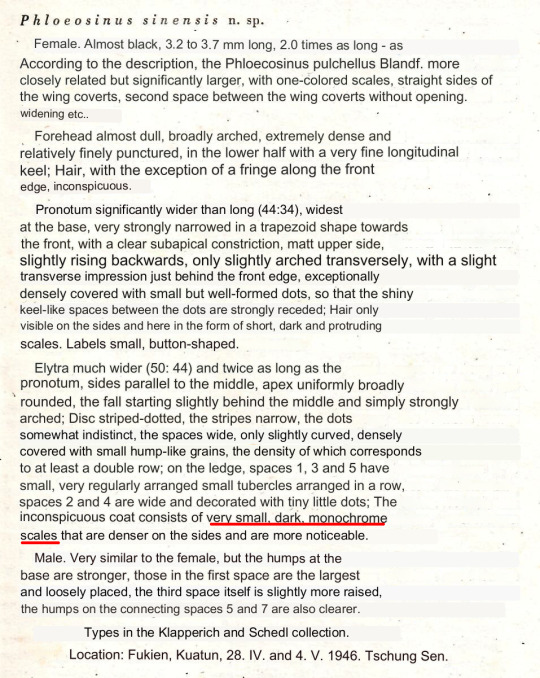
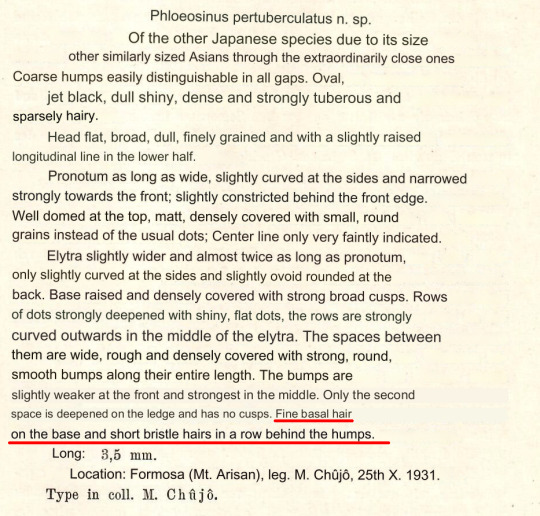
not the nicest translation but still an admirable attempt on google's part to deal with all the entomological jargon, and most importantly the description of the elytral scales on P. sinensis definitely seems to match my specimens more than the pertuberculatus. plus i found a paper on taiwanese bark beetles (PDF) coauthored by Dr Beaver that had a (also distressingly low-resolution) photo of pertuberculatus that didn't seem to match my specimens:

aaand finally: i'd been trying for days to access the webpage of a chinese museum that popped up as the only notable result on a google image search for P. sinensis but every time the website would time out and the cached version of the image was too small to make out any details on, but it finally occurred to me this evening that the reason was probably because my work computer or work wifi was just automatically blocking chinese websites because of america's insane paranoia about chinese spying, and sure enough i opened it up on my home computer and it fucking worked!

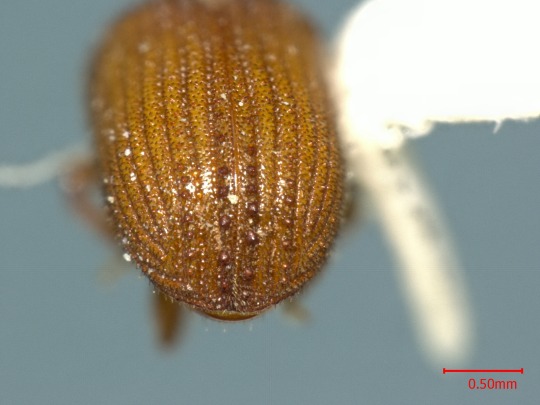

that's a pretty fucking bang-on match for my specimens! the scales look right, the color is right, the size is right, the ass bumps are right, the host is right, the geography is right, and the translated description otherwise seems to match! here's mine again so you don't have to scroll all the way up:

so i'm calling this 26-year mystery solved! not all of the bug puzzles i've worked on have had as meandering of a path to their conclusion as this, but i thought that this one did display a good number of the different methods i use. the biggest thing that was missing was me wandering into my lab's massive library of old dusty entomology journals stretching back over a century and digging out some old article that never got scanned and put online, as often happens, but in this case since the bugs were asian and out library mostly covers north american entomology that wasn't going to be very fruitful.
hopefully this was interesting to... somebody besides myself. if you've read this far and weren't bored to tears then congratulations you probably have the same kind of brain damage as me!

299 notes
·
View notes
Photo
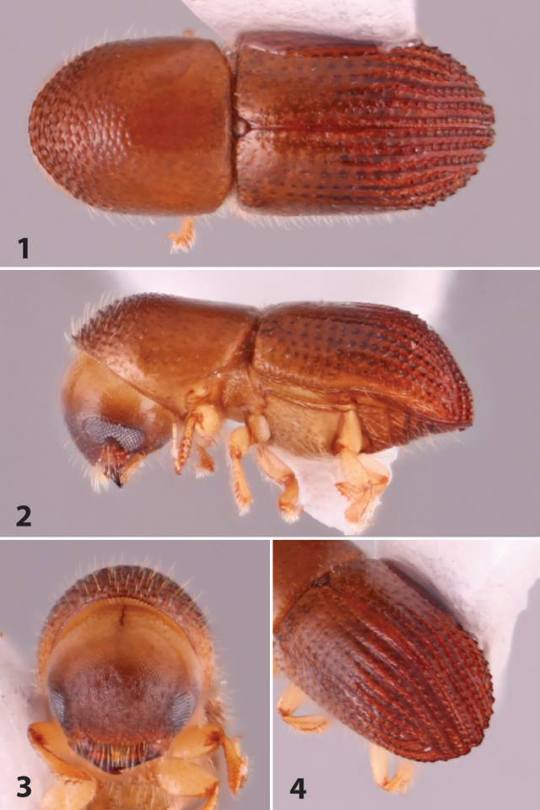
new Arixyleborus ambrisoa beetle species described in Smith et al 2019. what a lovely texture on that elytral declivity
48 notes
·
View notes